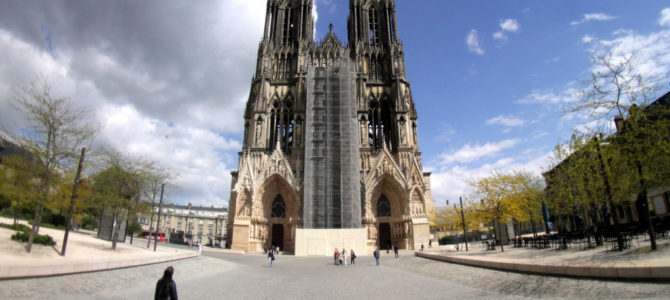
Responses to the devastation of the Notre Dame Cathedral went some way toward confirming Edward Norman’s judgment of some 30 years ago: “Of all the modern substitutes for religion, it is the aesthetic sense which is most esteemed.” An ecclesiastical historian and Anglican priest with deep sympathy for Catholicism, Norman argued that the aesthetic sense had become an unexpected, even paradoxical, handmaid of modern materialism. It mimics a sense of the sacred and borrows its vocabulary for refugees from mass culture.
More than a century and a half earlier, John Henry Newman anticipated the eventual melding of aesthetic response with religious sentiment. He predicted that feelings aroused by “accomplishments”—art, music, poetry—would blur with religious experience and, in time, be identified with it. Jacques Barzun concurred. In his 1973 Mellon Lectures, he stated: “The equivalence of art and religion is a fact.” To bolster the assertion, Barzun added: “A believer such as Cardinal Newman observed it.”
Echoing the cardinal, Norman warned against confusing aesthetic worth and its emotional promptings with religious sensation. To do so would sanctify Christianity’s secular replacement, a hybrid belief system that speaks in a Christian idiom while it adapts to an idol of the age. By way of example, consider the Catholic Artists Society. Without intending to, its reaction to the burning of the Notre Dame Cathedral illustrates Norman’s contention that contemporary Christians approach religion as if it were “a dimension of aesthetic consciousness.”
On April 15, the Society broadcast a brief, simple announcement of its eighth annual Mass for Artists, to be celebrated May 13 at the Church of St. Vincent Ferrer in Manhattan. It repeated its founding purpose “to invoke God’s blessings on all artists that their hearts might be cleansed and their minds enlightened by the inpouring of the Holy Spirit.”
Two days later, in the wake of news from Paris, the Society enlarged its message. It decided to pass the hat “to help fund the restoration of this priceless work of art and the sacred objects it contains.” The revision took on the tenor of a playbill:
Choral music will include Guillaume de Machaut’s Messe de Nostre Dame, the earliest complete polyphonic setting of the Mass Ordinary. It was composed for the Cathedral of Notre Dame, the birthplace of polyphony. Organ music will include compositions by Louis Vierne, organist of Notre Dame from 1900-1937.
The celebrant will be Fr. Sebastian White, O.P., Editor-in-Chief of Magnificat. The homilist will be Fr. Darren Pierre, O.P., Prior of Saint Vincent Ferrer and Vicar Provincial. The Schola Cantorum of Saint Vincent Ferrer, directed by James D. Wetzel, will provide the music.
The Mass will be held at the Church of St. Vincent Ferrer (869 Lexington Avenue at 66th St.). Completed in 1918 by renowned American architect Bertram Grosvenor Goodhue, it is one of the best examples in America of French Gothic-style architecture.
The press release ended with: “Bring a friend. Pray for Notre Dame at Mass. And toast her future health at the reception afterwards!” Her health? That gendered personification is telling. It divinizes the cathedral, investing it with the sacral aura that animates the poetic term Holy Mother Church. A rhetorical device, personification permits Notre Dame to pass from the temporal to the eternal, no longer stone and mortar but an Idea.
I dislike admitting it, but the announcement jars me some. It bespeaks a pride of association with historic grandeur unearned by any one of us—a mystic marriage between the generations that built this medieval gem and ourselves. It suggests that Catholic artists have a consuming stake in this one building that they do not have in churches designed by unremembered architects for ordinary congregants in disregarded places. Refined sensuality, mistaken for piety, determines the investment.
The Society’s stress on the artistry of the venue for its annual Mass poses a tension, if not competition, between two objects of worship: between the Creator and the handiwork of His creatures. Neither the cachet of the building, the prestige of its architect, nor the reputation of its choir adds to the efficacy of the Mass. The marrow of the annual Mass is the Mass itself, a communal act of prayer—not a concert, not a performance, not a first-rate troupe of players.
But that core bears only half its intention. The other half carries a stimulus to self-regard. It offers an occasion to exhibit the Society’s faith in art and its assumed prominence in the scale of social functions. We artists stand athwart the history of style, closer to the gods than the run of mortals. What F. Scott Fitzgerald said of the very rich parallels the still-breathing Romantic concept of artists: “They are different from you and me.”
It is a posture that goes back some centuries. Though to keep within living memory, we need go back no further than Paul VI’s 1965 formal address to artists: “Remember that you are the guardians of beauty in the world. May that suffice to free you from tastes which are passing and have no genuine value. Be always and everywhere worthy of your ideals and you will be worthy of the Church.”
John Paul II expanded on the trope, fulsome in his flattery of artists as “ingenious creators of beauty.” Benedict went full throttle, massaging both his predecessor (“an artist himself”) and his audience: “You are the custodians of beauty … you yourselves are to be heralds and witnesses of hope for humanity.”
The ideology of beauty has its devotional tricks. The rhetoric of recent popes is worth pausing over. But for now, stay with the reality of bruised and injured churches.
There are a number of them right now in the Diocese of Pensacola-Tallahassee. As the Society was taking donations for the Notre Dame, several Catholic churches in the Florida panhandle were still struggling to overcome the devastation of Hurricane Michael this past October.
Of those worst damaged, four have yet to recover. Major work remains to be done. This, in a part of the country that is far from affluent, and is regularly subject to tropical cyclones.
- Our Lady of Guadalupe, Mexico Beach, was completely destroyed. Its Web presence consists of only a single sentence: “The Church has been torn down and all the rubble has been hauled away. Soon some sort of grass will be planted there to prevent erosion.”
- Our Lady of The Rosary, Panama City, has had to demolish its rectory. It is still struggling to rebuild in the city where Hurricane Michael, a Category 5 hurricane, made landfall and wreaked the greatest harm.
- St. Dominic, Panama City, sustained significant damage to church, rectory, and grounds. The parish hall building was completely destroyed. A large stained glass window in the sanctuary was knocked out, roof damaged, steeple blown down, water let in.
- St. Joseph Parish, Port St. Joe, is trying to sell its badly damaged rectory to raise money to rebuild its demolished parish hall and install a new roof on the church.
- St. Peter and Paul, Panama City, was one of the lucky ones. It has been able to recover from the loss of its roof and severe water damage. However, the nun’s house across the street was destroyed.
No tears fall for these parishes that lack the supernal sheen of great architecture. Unremarkable places, they offer no reflecting mirror to the elect, those clean-hearted custodians of beauty. There is no national media coverage for them, no candlelight vigils, no collections spearheaded by art-loving billionaires or Catholics with patrician sensibilities.
The hidden God works without fanfare in the Florida panhandle.









